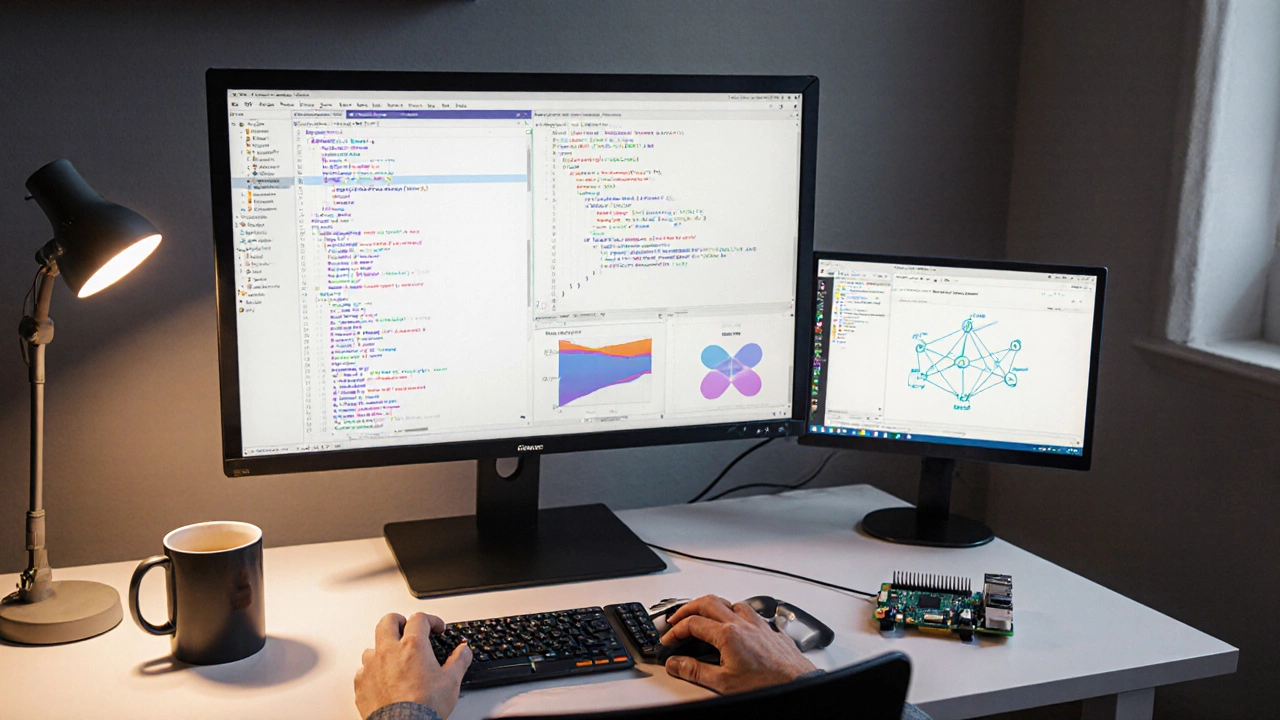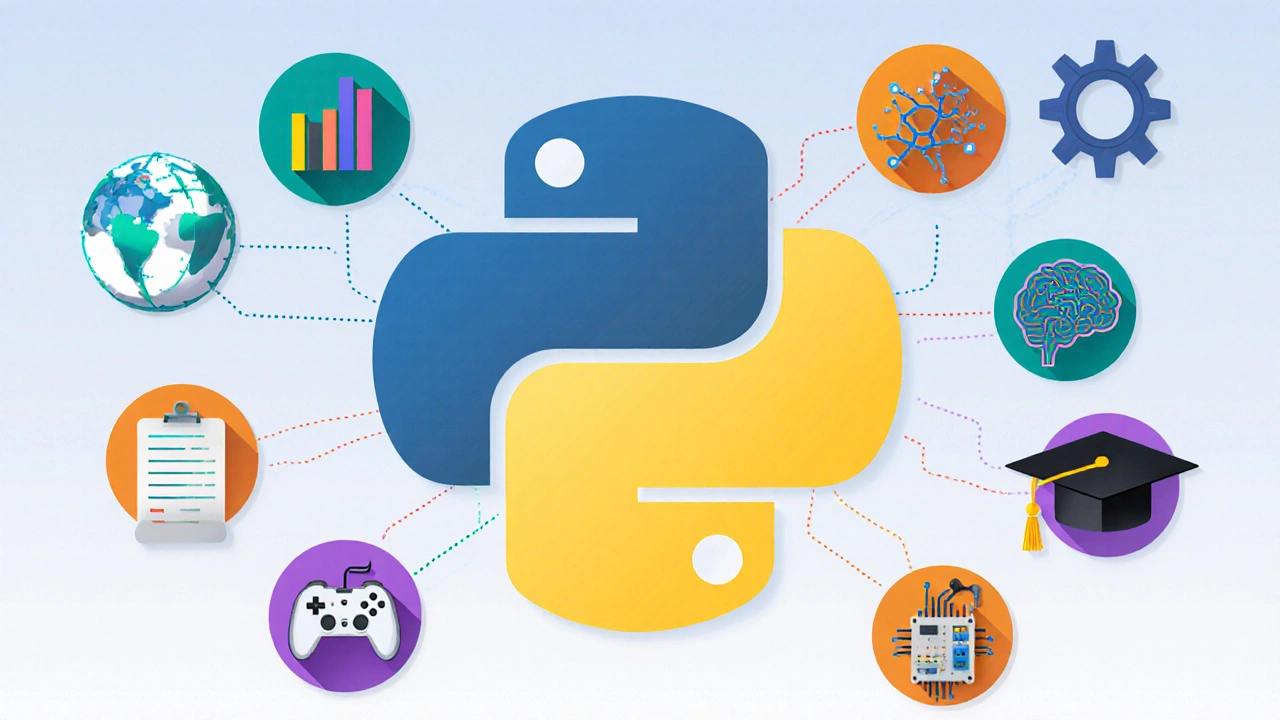Python Use Case Explorer
Explore how Python is used across different domains. Click on a category below to see real-world examples.
Web Development
Build dynamic websites with Django and Flask
Data Science & Analytics
Turn numbers into insights with pandas and NumPy
Machine Learning & AI
Teach computers to learn with TensorFlow and PyTorch
Automation & Scripting
Automate repetitive tasks with simple scripts
Game Development
Create interactive experiences with Pygame
IoT & Embedded Systems
Bring Python to microcontrollers and devices
Education & Research
Teach programming and conduct research
Ever wonder why Python shows up in everything from Instagram’s backend to NASA’s research labs? The answer lies in its versatility - an easy‑to‑learn language that scales from quick scripts to massive data pipelines. Below, we break down the most common ways developers and organizations put Python to work, so you can spot the right fit for your next project.
TL;DR - Quick Takeaways
- Python powers the web, data science, AI, automation, games, IoT, and education.
- Its standard library and huge ecosystem of third‑party packages accelerate development.
- Choose a domain, learn the core libraries (Django/Flask, pandas, TensorFlow, PyAutoGUI, Pygame, MicroPython, etc.), and start building.
- Community support and extensive documentation lower the learning curve.
- Python’s readability makes it ideal for both beginners and seasoned engineers.
Web Development - Building Dynamic Sites with Python
When you hear "Python is great for web development," the first thing that comes to mind is Django, a high‑level web framework that follows the "batteries‑included" philosophy. Django ships with an ORM, authentication, admin panel, and URL routing right out of the box, letting teams launch MVPs in weeks. For lighter projects, Flask offers a minimalist core and lets you pick only the extensions you need, such as Jinja2 for templating or SQLAlchemy for database access.
Key advantages for web developers:
- Rapid prototyping - write less boilerplate code.
- Scalable architecture - both frameworks support horizontal scaling via WSGI servers like Gunicorn.
- Large community - hundreds of plugins for payments, REST APIs, and social login.
Popular sites built with Python include Instagram, Pinterest, and the content‑management system Plone. If you’re aiming for a data‑driven web app, Python’s integration with analytics tools makes it a natural choice.
Data Science & Analytics - Turning Numbers into Insights
Data scientists love Python because it reads like plain English. The core pandas library provides fast, flexible DataFrames, while NumPy adds vectorized operations and linear‑algebra tools. Visualizations are a breeze with Matplotlib, Seaborn, or interactive dashboards built with Plotly.
Real‑world use cases:
- Financial firms run ETL pipelines that pull market data, clean it with pandas, and store results in PostgreSQL.
- Health‑care researchers analyze patient records to find treatment patterns, using SciPy for statistical tests.
- E‑commerce platforms segment customers based on purchase history, then feed the groups into recommendation engines.
Because Python integrates well with big‑data ecosystems (Spark via PySpark, Hadoop, and cloud services like AWS Glue), it scales from a single Jupyter notebook to a multi‑node cluster.
Machine Learning & AI - Teaching Computers to Learn
When it comes to Python uses in AI, the ecosystem speaks for itself. TensorFlow and PyTorch dominate deep‑learning research, offering GPU acceleration and dynamic computation graphs. For classical ML algorithms, scikit‑learn provides ready‑to‑use models for classification, regression, clustering, and more.
Typical AI projects include:
- Image recognition for autonomous vehicles - training convolutional neural networks on labeled datasets.
- Natural language processing for chatbots - using Transformer models like BERT via the Hugging Face library.
- Predictive maintenance in manufacturing - feeding sensor data into time‑series models to forecast equipment failures.
Start small with Jupyter notebooks, then move the trained model into production using Flask APIs or specialized serving platforms like TensorFlow Serving.

Automation & Scripting - Making Repetitive Work Disappear
Python’s straightforward syntax makes it the go‑to language for automating daily tasks. The os and shutil modules let you manipulate files, while requests handles HTTP calls for web‑scraping or API interaction.
Common automation scenarios:
- Generating daily reports - pull data from a database, format it with pandas, email it via smtplib.
- CI/CD pipelines - write custom scripts for test execution, artifact packaging, and deployment.
- System administration - use Paramiko for SSH automation across servers.
Because Python runs on Windows, macOS, and Linux, you can write a single script and deploy it everywhere.
Game Development - Building Interactive Experiences
While C++ dominates AAA titles, Python shines in indie games, prototypes, and educational simulations. Pygame offers a simple wrapper around SDL, letting you manage graphics, sound, and input with just a few lines of code. For 3D projects, Godot includes a Python‑like scripting language called GDScript, which feels familiar to Python developers.
Typical uses:
- Educational games that teach math or coding concepts.
- Rapid prototypes to test game mechanics before committing to a high‑performance engine.
- Tools for level design, asset conversion, or automated testing of game builds.
Internet of Things (IoT) & Embedded Systems - Python on the Edge
Embedded devices once required low‑level C code, but today MicroPython and CircuitPython bring Python to microcontrollers like the ESP32, Raspberry Pi Pico, and Arduino. These runtimes pack a small interpreter, allowing developers to write sensor‑reading loops, MQTT clients, and actuator controls in familiar Python syntax.
Practical IoT projects:
- Home‑automation hubs that collect temperature and humidity data, then publish to Home Assistant.
- Wearable health trackers that process accelerometer data in real time.
- Industrial edge devices that perform on‑device anomaly detection before sending alerts.
Because MicroPython supports REPL over serial, debugging is as simple as typing commands directly into the device.
Education & Research - Teaching and Discovering with Python
Universities and bootcamps favor Python for introductory programming courses. Its readability reduces the cognitive load on beginners, while libraries like SymPy enable symbolic mathematics, and Jupyter notebooks blend code, equations, and narrative text.
Research domains that rely heavily on Python:
- Computational biology - using Biopython for genome analysis.
- Physics simulations - leveraging NumPy and SciPy for differential equations.
- Social science analytics - combining pandas with network‑analysis packages like NetworkX.
Students can prototype experiments within hours, and the open‑source nature means they can publish reproducible notebooks alongside papers.
Choosing the Right Python Path - Tips for Getting Started
- Identify your goal. Want a web app? Dive into Django. Need data insight? Start with pandas.
- Pick a starter project. Build a todo list (web), a sales‑forecast script (automation), or a sentiment‑analysis notebook (ML).
- Leverage community resources. Stack Overflow, official docs, and YouTube tutorials fill gaps fast.
- Practice regularly. The more you code, the faster you’ll spot Python’s idiomatic patterns.
Remember, Python’s strength is its ecosystem. Install packages with pip, explore virtual environments, and keep your codebase clean with tools like black and flake8. Within weeks you’ll be moving from hello‑world scripts to production‑ready solutions.

Frequently Asked Questions
Can I use Python for mobile app development?
Yes. Frameworks like Kivy and BeeWare let you write once and deploy to iOS and Android, though performance‑critical apps may still favor native languages.
Is Python fast enough for real‑time systems?
Python isn’t ideal for hard real‑time constraints, but you can offload heavy computation to C extensions or use just‑in‑time compilers like Numba. For many IoT or robotics tasks, the speed is sufficient when paired with efficient libraries.
Do I need to learn another language after Python?
It depends on your goals. Web front‑ends require JavaScript, while high‑performance game engines use C++ or C#. However, Python’s versatility means you can stay productive in many domains without switching languages frequently.
How does Python compare to R for data analysis?
Python offers a broader ecosystem (web, automation, AI) and integrates well with production pipelines. R excels in statistical modeling and has many niche packages. For most teams, Python’s readability and library breadth make it the preferred choice.
What’s the best way to learn Python for absolute beginners?
Start with the official Python Tutorial, then practice on platforms like Codecademy or freeCodeCamp. Build small scripts daily, then progress to a project that interests you - a personal budget tracker, a simple game, or a data‑visualization notebook.
